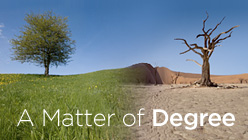
Keep emotions out of it and meet the uncertainties head-on. Those tips are among the advice offered in a new guide for climate change communicators. Published by the Center for Research on Environmental Decisions at Columbia University, “The Psychology of Climate Change Communication” is a 54-page guide available on the CRED website that attempts to help educators, journalists, and scientists communicate more clearly about the complicated, politically-charged subject of climate change. The gist? It’s not just what you say, it’s how you say it. Not that this is an earth-shattering revelation but it’s a good reminder to those tasked with conveying detailed scientific information to a general audience that might not have the time, context, or desire to fully process the message.
From the introduction:
… in order for climate science information to be fully absorbed by audiences, it must be actively communicated with appropriate language, metaphor, and analogy; combined with narrative storytelling; made vivid through visual imagery and experiential scenarios; balanced with scientific information; and delivered by trusted messengers in group settings.
This guide speaks to the messengers. Key recommendations include common-sense strategies such as knowing your audience, getting their attention, and being sure to translate scientific data into concrete experience. The guide also stresses avoiding the overuse of emotional appeals reasoning that while they may work in the short term, they could backfire down the road because people have a “finite pool of worry” and repeated emotional appeals could lead to “emotional numbing” and apathy. Most of these recommendations sound useful for all kinds of communication — not just about climate change.
One point, however, seems especially relevant to climate change; the recommendation to directly and precisely address scientific and climatic uncertainties. In other words, meet the unknowns head-on but keep them in perspective:
Climate science uncertainty often conveys the mistaken impression that scientists are hopelessly confused about this complicated subject, when in fact scientific uncertainties about exactly how much warmer the planet will be in 100 years does not change the very high confidence scientists have that human-made greenhouse gas emissions are warming the planet and are likely to continue doing so.
The guide stresses the importance of being very clear about where the uncertainties lie, because they are easy to overstate or understate, which leads to more confusion. A particularly interesting resource is Table 4: Words with Different Meanings to Scientists and the General Public. The table itself is a little confusing, but it gives recognition to the “language barrier” between scientists and “laymen,” a key to getting a clear message across.
A study published last month by the Pew Center for People and the Press found that the percentage of American adults who think that there is solid evidence that the average temperature on earth has been getting warmer over the past few decades has declined over the past year, from 71% to 57%. The proportion of Americans who say global temperatures are rising as a result of human activity, such as burning fossil fuels, shrank from 47% to 36% in the same period. It’s an indication that those who have taken on the mantle of communicating the current science can use a little help.
